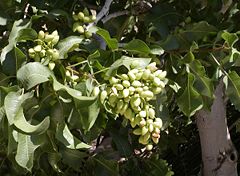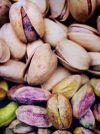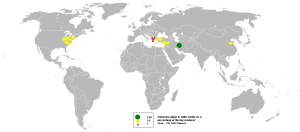Pistachio
| Pistachio | ||||||||||||||
|---|---|---|---|---|---|---|---|---|---|---|---|---|---|---|
 Pistachio with ripening fruit
| ||||||||||||||
| Scientific classification | ||||||||||||||
| ||||||||||||||
| Pistacia vera L. |
The pistachio (Pistacia vera L., Anacardiaceae; sometimes placed in Pistaciaceae) is a small tree up to 10 m tall, native to mountainous regions of Iran, Turkmenistan and western Afghanistan. It has deciduous pinnate leaves 10–20 cm long.
The plants are dioecious, with separate male and female trees. The flowers are apetalous and unisexual, and borne in panicles. The fruit is a drupe, containing an elongated seed (a nut in the culinary sense, but not a true botanical nut) with a hard, whitish shell and a striking kernel which has a mauvish skin and light green flesh, with a distinctive flavour.
When the fruit ripens, the husk changes from green to an autumnal yellow/red and the shells split partially open (see photo). This is known as dehiscence, and happens with an audible pop.
Each pistachio nut weighs around 1 gram, [1] and each pistachio tree averages around 50 kg of nuts, or around 50,000, every two years. [2] Pistachios (as part of the pistacia genus) have existed for about 80 million years. [3]
History
Pistachio is often confused with some of the other nine species in the genus Pistacia, such as P. terebinthus and P. lentiscus. These species have a very different distribution, in the Mediterranean and southwest Asia, and have much smaller nuts, lacking the hard shell of P. vera. Their turpentine-flavoured nuts were a popular food in antiquity. Finds of Pistacia from pre-classical archaeological sites, or references in pre-classical texts, always refer to one of these other species (often P. terebinthus).
Pistachio (in the sense of P. vera) was first cultivated in Western Asia. It reached the Mediterranean world by way of central Iran, where it has long been an important crop. Although known to the Romans, the pistachio nut appears not to have reached the Mediterranean or most of the Near East in any quantity before medieval times. More recently pistachio has been cultivated in California (first commercial harvest in 1976) and Australia. The word pistachio is a Persian loanword, coming into English through Italian, and is a cognate to the Modern Persian word پسته Peste'.
Cultivation and uses
The kernels are often eaten whole, either fresh or roasted and salted, and are also used in ice cream and confections such as baklava. In July 2003, the Food and Drug Administration (FDA) approved the first qualified health claim specific to nuts lowering the risk of heart disease: "Scientific evidence suggests but does not prove that eating 1.5 ounces (42.5g) per day of most nuts, such as pistachios, as part of a diet low in saturated fat and cholesterol may reduce the risk of heart disease".[1]. In research at Pennsylvania State University, pistachios in particular significantly reduced levels of LDL, the 'bad' cholesterol, in the blood of volunteers.[2] Pennsylvania State University's Department of Nutrition and Sciences has also conducted related research on other health benefits of pistachios, including an April 2007 study concluding that pistachios may calm acute stress reaction,[3] and a June 2007 study on the cardiovascular health benefits of eating pistachios.[4]
On the Greek island of Chios, the husk or flesh of the pistachio fruit surrounding the shell is cooked and preserved in syrup.
The shell of the pistachio is naturally a beige colour, but it is sometimes dyed red or green in commercial pistachios. Originally the dye was applied by importers to hide stains on the shells caused when the nuts were picked by hand. However most pistachios are now picked by machine and the shells remain unstained, making dyeing unnecessary (except that some consumers have been led to expect coloured pistachios). Roasted pistachio nuts can be artificially turned red if they are marinated prior to roasting in a salt and strawberry marinade, or salt and citrus salts.
The trees are planted in orchards, and take approximately seven to ten years to reach significant production. Production is alternate bearing or biennial bearing, meaning the harvest is heavier in alternate years. Peak production is reached at approximately 20 years. Trees are usually pruned to size to make the harvest easier. One male tree produces enough pollen for eight to twelve nut-bearing females. Pistachio orchards can be damaged by the fungal disease Botryosphaeria panicle and shoot blight, which kills the flowers and young shoots.
Pistachio trees are fairly hardy in the right conditions, and can survive temperature ranges between −10°C (14°F) in winter to 40°C (104°F) in summer. They need a sunny position and well-drained soil. Pistachio trees do poorly in conditions of high humidity, and are susceptible to root rot in winter if they get too much water and the soil is not sufficiently free draining. Long hot summers are required for proper ripening of the fruit.
Pistachio nuts are highly flammable when stored in large quantities, and are prone to self heating and spontaneous combustion.[5]
Diseases
Worldwide production
Share of a total 2005 worldwide production of 501 thousand metric tonnes[6]:
| Country | Production (tonnes) |
|---|---|
| Iran | 190 000 |
| U.S. | 140 000 |
| Turkey | 60 000 |
| Syria | 60 000 |
| China | 34 000 |
| Greece | 9 500 |
| Italy | 2 400 |
| Uzbekistan | 1 000 |
| Tunisia | 800 |
| Pakistan | 200 |
| Madagascar | 160 |
| Kyrgyzstan | 100 |
| Morocco | 50 |
| Cyprus | 15 |
| Mexico | 7 |
| Mauritius | 5 |
California produces almost all U.S. pistachios, and about half of these are exported, mainly to China, Japan, Europe and Canada. Almost all California pistachios are of the cultivar 'Kerman'. The tree is grafted to a rootstock when the rootstock is one year old. Only a few years after California growers started growing pistachios, the 1979 crisis in Iran would give stronger commercial impetus to the American-based pistachio nut industry. Previous to that time, most Westerners were familiar with only the slightly smaller, deeply red-hued (dyed) nuts produced mainly in Iran, where it is the second largest export after oil. [citation needed]
Notes and references
- ↑ FDA Office of Nutritional Products, Labeling and Dietary Supplements, Center for Food Safety and Applied Nutrition (July 2003) “Qualified Health Claims: Letter of Enforcement Discretion - Nuts and Coronary Heart Disease” (Docket No 02P-0505)
- ↑ Daily Telegraph (London) 2 May 2007
- ↑ DailyScience.com, via PistachioHealth.com, link and copy of April 2007 Pennsylvania State University research study
- ↑ PistachioHealth.com link to PDF copy of June 2007 Pennsylvania State University Cardiovascular Health Pistachio study
- ↑ http://www.containerhandbuch.de/chb_e/scha/index.html?/chb_e/scha/scha_13_06.html Cargo container's handbook].
- ↑ Food & Agricultural Organization of the UN estimates
See also
- List of culinary nuts
External links
- Germplasm Resources Information Network: Pistacia vera
- California Pistachio Commission
- Nutrition facts
- Pistachio Ice Cream From Scratch with step-by-step pictures
- PistachioHealth.com - Pistachio Health and Nutrition Information
- Kara Food Machinery
Credits
New World Encyclopedia writers and editors rewrote and completed the Wikipedia article in accordance with New World Encyclopedia standards. This article abides by terms of the Creative Commons CC-by-sa 3.0 License (CC-by-sa), which may be used and disseminated with proper attribution. Credit is due under the terms of this license that can reference both the New World Encyclopedia contributors and the selfless volunteer contributors of the Wikimedia Foundation. To cite this article click here for a list of acceptable citing formats.The history of earlier contributions by wikipedians is accessible to researchers here:
The history of this article since it was imported to New World Encyclopedia:
Note: Some restrictions may apply to use of individual images which are separately licensed.


